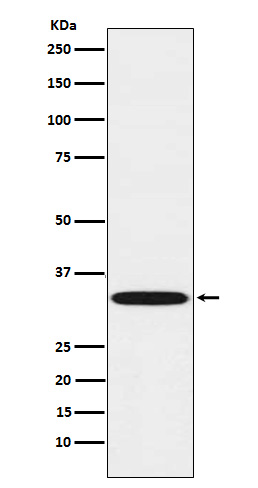Anti-TREX1 Rabbit Monoclonal Antibody
- SPECIFICATION
- CITATIONS
- PROTOCOLS
- BACKGROUND

Application
| WB, IHC, IF, ICC |
|---|---|
| Primary Accession | Q9NSU2 |
| Host | Rabbit |
| Isotype | IgG |
| Reactivity | Human |
| Clonality | Monoclonal |
| Format | Liquid |
| Description | Anti-TREX1 Rabbit Monoclonal Antibody . Tested in WB, IHC, ICC/IF applications. This antibody reacts with Human. |
| Gene ID | 11277 |
|---|---|
| Other Names | Three-prime repair exonuclease 1, 3.1.11.2, 3'-5' exonuclease TREX1, Deoxyribonuclease III, DNase III, TREX1 {ECO:0000303|PubMed:10391904, ECO:0000312|HGNC:HGNC:12269} |
| Calculated MW | 33 kDa |
| Application Details | WB 1:500-1:2000 IHC 1:50-1:200 ICC/IF 1:50-1:200 |
| Contents | Rabbit IgG in phosphate buffered saline, pH 7.4, 150mM NaCl, 0.02% sodium azide and 50% glycerol, 0.4-0.5mg/ml BSA. |
| Clone Names | Clone: 19T02 |
| Immunogen | A synthesized peptide derived from human TREX1 |
| Purification | Affinity-chromatography |
| Storage | Store at -20°C for one year. For short term storage and frequent use, store at 4°C for up to one month. Avoid repeated freeze-thaw cycles. |
| Name | TREX1 {ECO:0000303|PubMed:10391904, ECO:0000312|HGNC:HGNC:12269} |
|---|---|
| Function | Major cellular 3'-to-5' DNA exonuclease which digests single- stranded DNA (ssDNA) and double-stranded DNA (dsDNA) with mismatched 3' termini (PubMed:10391904, PubMed:10393201, PubMed:17293595). Prevents cell-intrinsic initiation of autoimmunity (PubMed:10391904, PubMed:10393201, PubMed:17293595). Acts by metabolizing DNA fragments from endogenous retroelements, including L1, LTR and SINE elements (PubMed:10391904, PubMed:10393201, PubMed:17293595). Plays a key role in degradation of DNA fragments at cytosolic micronuclei arising from genome instability: its association with the endoplasmic reticulum membrane directs TREX1 to ruptured micronuclei, leading to micronuclear DNA degradation (PubMed:33476576). Micronuclear DNA degradation is required to limit CGAS activation and subsequent inflammation (PubMed:33476576). Unless degraded, these DNA fragments accumulate in the cytosol and activate the cGAS-STING innate immune signaling, leading to the production of type I interferon (PubMed:33476576). Prevents chronic ATM-dependent checkpoint activation, by processing ssDNA polynucleotide species arising from the processing of aberrant DNA replication intermediates (PubMed:18045533). Inefficiently degrades oxidized DNA, such as that generated upon antimicrobial reactive oxygen production or upon absorption of UV light (PubMed:23993650). During GZMA-mediated cell death, contributes to DNA damage in concert with NME1 (PubMed:16818237). NME1 nicks one strand of DNA and TREX1 removes bases from the free 3' end to enhance DNA damage and prevent DNA end reannealing and rapid repair (PubMed:16818237). |
| Cellular Location | Nucleus. Cytoplasm, cytosol. Endoplasmic reticulum membrane; Peripheral membrane protein. Note=Retained in the cytoplasm through the C-terminal region (By similarity). Localization to the endoplasmic reticulum membrane is required to direct TREX1 to ruptured micronuclei (PubMed:33476576). In response to DNA damage, translocates to the nucleus where it is specifically recruited to replication foci (PubMed:16818237). Translocation to the nucleus also occurs during GZMA-mediated cell death (PubMed:16818237) {ECO:0000250|UniProtKB:Q91XB0, ECO:0000269|PubMed:16818237, ECO:0000269|PubMed:33476576} |
| Tissue Location | Detected in thymus, spleen, liver, brain, heart, small intestine and colon. |

Thousands of laboratories across the world have published research that depended on the performance of antibodies from Abcepta to advance their research. Check out links to articles that cite our products in major peer-reviewed journals, organized by research category.
info@abcepta.com, and receive a free "I Love Antibodies" mug.
Provided below are standard protocols that you may find useful for product applications.
If you have used an Abcepta product and would like to share how it has performed, please click on the "Submit Review" button and provide the requested information. Our staff will examine and post your review and contact you if needed.
If you have any additional inquiries please email technical services at tech@abcepta.com.













 Foundational characteristics of cancer include proliferation, angiogenesis, migration, evasion of apoptosis, and cellular immortality. Find key markers for these cellular processes and antibodies to detect them.
Foundational characteristics of cancer include proliferation, angiogenesis, migration, evasion of apoptosis, and cellular immortality. Find key markers for these cellular processes and antibodies to detect them. The SUMOplot™ Analysis Program predicts and scores sumoylation sites in your protein. SUMOylation is a post-translational modification involved in various cellular processes, such as nuclear-cytosolic transport, transcriptional regulation, apoptosis, protein stability, response to stress, and progression through the cell cycle.
The SUMOplot™ Analysis Program predicts and scores sumoylation sites in your protein. SUMOylation is a post-translational modification involved in various cellular processes, such as nuclear-cytosolic transport, transcriptional regulation, apoptosis, protein stability, response to stress, and progression through the cell cycle. The Autophagy Receptor Motif Plotter predicts and scores autophagy receptor binding sites in your protein. Identifying proteins connected to this pathway is critical to understanding the role of autophagy in physiological as well as pathological processes such as development, differentiation, neurodegenerative diseases, stress, infection, and cancer.
The Autophagy Receptor Motif Plotter predicts and scores autophagy receptor binding sites in your protein. Identifying proteins connected to this pathway is critical to understanding the role of autophagy in physiological as well as pathological processes such as development, differentiation, neurodegenerative diseases, stress, infection, and cancer.


